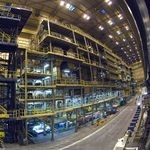 In a difficult market environment, given the business environment has not yet emerged from recession, and the European construction market fell by 20% below the 2007 level, the international companies operating in the area have reconfirmed their objectives to increase businesses by 3% - 5% in 2014. Also, among their objectives there are targets as important increases at the organic level, while improving profitability. Sector demand remains heterogeneous from region to region, due to the difficult political and economic situation in many countries. Such difficulties can be seen in Russia, a major market for most companies in the Europe, where the consequences of the conflict with Ukraine hampers the economic activity and creates unpredictability. On a negative trend was the activity in North America, where the demand in January - June 2014 was below the levels recorded in previous semesters. The first half of 2014 represented a mostly atypical period for the North American construction activity, and it was adversely affected by the raising euro-dollar parity in favor of the euro. However, in 2014 the companies managers expect a gradual improvement of sales, given that, according to Euroconstruct, the European construction market increased slightly in the first half of 2014 and is expected to grow by 2% per year from 2014 to 2016. However, the industry is currently to 20% below 2007, which indicates that an additional 2% per year is insufficient to determine the dynamics for sustainable growth. The decision makers of the major international holdings expect the Russia - Ukraine conflict to escaladate, and the geopolitical issues in the Middle East to have further negative impact on the current economic context. New residential construction in total is expected to grow by 3.2% on average in 2014-2016 and residential renovation and maintenance (R&M) by only 1.2% a year, pulling down average growth in total residential construction to 2% a year in real terms. Although most EC countries are clear of recession, sluggish domestic demand growth and weak public sector finances will most likely continue to dampen non-residential building demand for some time.
In a difficult market environment, given the business environment has not yet emerged from recession, and the European construction market fell by 20% below the 2007 level, the international companies operating in the area have reconfirmed their objectives to increase businesses by 3% - 5% in 2014. Also, among their objectives there are targets as important increases at the organic level, while improving profitability. Sector demand remains heterogeneous from region to region, due to the difficult political and economic situation in many countries. Such difficulties can be seen in Russia, a major market for most companies in the Europe, where the consequences of the conflict with Ukraine hampers the economic activity and creates unpredictability. On a negative trend was the activity in North America, where the demand in January - June 2014 was below the levels recorded in previous semesters. The first half of 2014 represented a mostly atypical period for the North American construction activity, and it was adversely affected by the raising euro-dollar parity in favor of the euro. However, in 2014 the companies managers expect a gradual improvement of sales, given that, according to Euroconstruct, the European construction market increased slightly in the first half of 2014 and is expected to grow by 2% per year from 2014 to 2016. However, the industry is currently to 20% below 2007, which indicates that an additional 2% per year is insufficient to determine the dynamics for sustainable growth. The decision makers of the major international holdings expect the Russia - Ukraine conflict to escaladate, and the geopolitical issues in the Middle East to have further negative impact on the current economic context. New residential construction in total is expected to grow by 3.2% on average in 2014-2016 and residential renovation and maintenance (R&M) by only 1.2% a year, pulling down average growth in total residential construction to 2% a year in real terms. Although most EC countries are clear of recession, sluggish domestic demand growth and weak public sector finances will most likely continue to dampen non-residential building demand for some time.





